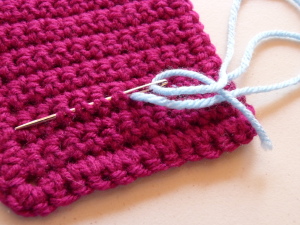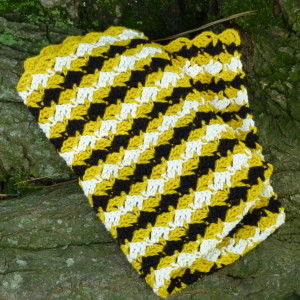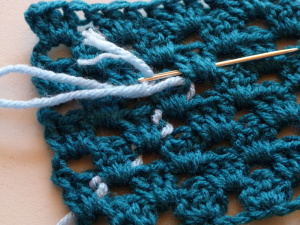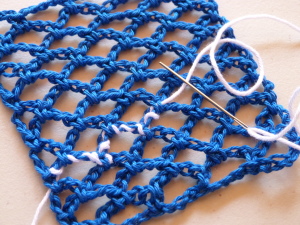How to Weave in Ends – Part 2
By Amy Yarbrough – 3 CommentsWelcome back to How to Weave in Ends! In part one, we talked about the importance of weaving in yarn tails and a couple of ways to do it. Now I am going to show you what to do when working the tails into the row ends isn’t a good choice.
In the same way I showed you how to weave the tails into the single crochet border, simple weaving in behind a few strands of the stitches in the pattern piece is fairly quick and great for pieces with a wrong side. I recommend this method for solid stitch patterns like the one in the picture below.

Tip #2: After weaving a tail in, give the material a stretch so that the tail will look more natural and you can clip off any ends that show.
Openwork and Lace
Working the tails in openwork and lace material takes some strategy. Often there is no wrong side, and since there are breaks in the stitch continuity, you must approach it with care.
For example, this Diamond Dish Towel, part of the Bumblebee Dish Towel Set, creates many loose ends. Crocheting over them in the actual piece (since there isn’t any border to work with) would allow the tails to show through the openwork stitch, while weaving them in along the row ends would result in mixing colors. You will need to take the tails into the stitches.

Here’s how. Take a look at this swatch of 3-double crochet groups.

Taking the needle and weaving into the stitches and between the bases of them will hide the tail. Try to avoid weaving into a stitch that you have already woven a tail into or you will end up with a noticeable bulge.
Lacy stitches, especially when using a fragile yarn or thread, may become difficult to hide yarn tails in, and twice as difficult to keep them in.
Tip #3: After working the yarn tail through the stitches, come back the opposite way to better prevent the tail ends from poking out later on.
You are going to follow the flow of the stitch, similar to the way you saw me do with the 3-dc groups.
Now just how you work in, whether up or down, or across or backwards, is entirely up to you. The whole idea is to hide it in the stitches you have, no matter how far apart they may be. Here is how I do it:

When working in tails of the same color, the weaving won’t be as noticeable. If you find that hard to believe, try and find the actual tails to the piece I have already woven in. Now do you see what I mean?
I have show you some of the most common ways to weave in those unpleasant yarn tails. But always remember, there really are no rules to the “artâ€. If you have a way of doing it that is different than mine, please feel free to share it with us. We at Crochet Spot are always eager to know what our readers think.
Thanks for reading!


Thank you for the finishing tips…greatly apprecicated and also love the corner 2 corner patterns for lefties, all your tips and instructions have certainly helped me out greatly.
Im always on the lookout for the next newsletter.
Thanks for the tips.
Great tips!! Always something practical and interesting on crochet spot.